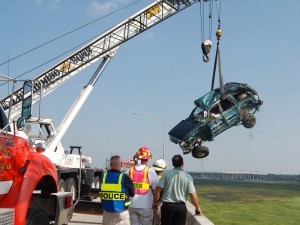We document accident scenes and vehicles with photographs, total station measurements and inspection notes. We recommend doing the inspections as quickly after the accident as possible, but with photogrammetry, total station measurements, three dimensional computer aided design (CAD) and other advanced tools we can often recreate important data years after the accident.
Areas we typically address in vehicle inspections:
- Crush of body panels and underlying vehicle components help to identify the orientation of vehicle during an accident and it can sometimes be used to determine the speed of the vehicle or other vehicles at impact. Roof crush involving the pillars can help to identify if a seatbelt became loose due to crash damage.
- Paint transfer from an impacting vehicle helps to identify interaction between two or more vehicles and can sometimes show that a vehicle went out of control because of contact from a second vehicle.
- Scratch pattern analysis is most useful in rollover accidents. The direction of the scratches helps to identify the orientation of the vehicle when it contacted either road surfaces or shoulders. Which scratches are on top of other scratches helps to identify the order in which the vehicle contacted a surface. The combination of the two pieces of information helps to identify the motions of the vehicle during the rollover.
- Tires and wheels are examined for tread depth, pressure, loss of tread, cracking, scuffing, debonding, aggregate abrasion, etc. For instance, in an edge drop-off case, the scuffing of the inside sidewall might indicate that the edge-drop-off contributed to a loss of control.
- Seatbelts are sometimes examined to help identify whether a seatbelt was being worn during an accident.
- Windows are examined to identify whether they are intact, cracked, show evidence of being struck by an object and for a side window whether the window was up or down when it was broken. In an ejection case, it can be important whether a window was open or closed prior to the ejection.
- Vehicles are sometimes examined for defects, damage or system failures that might have contributed to a loss of control.
- If an airbag module or truck ECM is downloadable, the inspection of the vehicle will often include removal of the module or download of the data.
- For heavy trucks, brakes are examined to determine the amount of throw of an airbrake and the amount of lining thickness for the brake.
- In night time accidents, the headlights, tail lights and brake light bulbs will be examined to determine if the bulbs were lit at the time of the accident.

